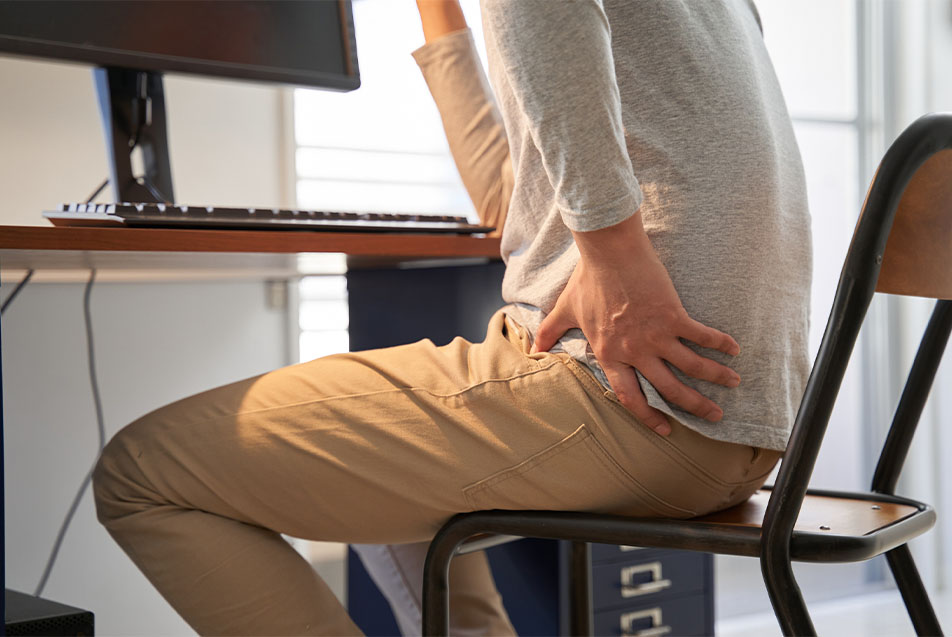
Lower back and hip pain are not uncommon, but they can be extremely uncomfortable and affect your mobility and quality of life. Whether it's a muscle strain or pinched nerve, Michael Koenig, PA-C, PPG – Orthopedics, helps illuminate the connection between the two ailments and answers our questions as to how one could be contributing to the other.
How are the hip and back connected?
Anatomically, the hip and back connect through the sacroiliac (SI) joint. This joint connects the hip bones to your sacrum, the bone between your lumbar spine (lower back) and tailbone.
How often are back and hip pain mistaken for each other?
It happens more often than you might think. Since the hips and lower spine are so close together, it's easy to mistake back pain for hip pain or vice versa. It's not uncommon to see people come in complaining of hip pain when, after doing an exam and listening to their symptoms, it's a back problem or issue contributing to their overall pain. Unfortunately, the signs for each can be easily confused for one another.
What are the most common culprits of low back and/or hip pain?
A lot of that depends on the demographic of the patient that you're treating. Younger individuals will have different hip pathology than the elderly (and vice versa), but most low back pain and hip pain often share common causes. A few of the most common culprits can include:
- Normal wear and tear due to aging or overuse
- Lumbar sprains and strains
- Osteoarthritis
- Herniated discs
- Degeneration
What are the signs that someone's hip or back/spine is the source of the pain?
Generally, if someone comes in with groin pain and they can localize it to that area, that usually means the hip is the culprit. Also, individuals with hip pain usually don't like walking or standing and usually find relief with rest.
On the flip side, if someone comes in and says their hip is hurting and indicates the pain is originating gluteal, it's most likely a back problem. Additionally, individuals with back problems usually don't like to sit. They want to pace or walk and typically choose either as their position of comfort.
What advice would you give someone trying to pinpoint the source of the problem?
If you're trying to figure out the problem or what's causing your pain, it's best to keep track of your symptoms. That way, when the pain flairs up, you can ask yourself these questions:
- What made it better?
- What made it worse?
- What did I do differently this time?
- Is there anything that may have contributed to the pain?
Then, be sure to share your history, symptoms and tracking efforts with your medical provider. It can be extremely helpful in pinpointing the root of the problem.
When should someone see a doctor or seek medical intervention?
Ideally, whenever they want to, but preferably before the pain escalates, and their symptoms start to affect their daily routine or life. If someone has questions or concerns, and there's something we can do to help, we want to see them.
With that said, there are some warning signs and red flags people need to watch for, including:
- If they’ve had a trauma and now there’s a problem.
- If they develop a fever.
- If they have bowel or bladder dysfunction.
- If they have unexplained weight loss.
- If they have a history of cancer.
- If they suddenly experience pain and can't account for it.
These are all things that should prompt a visit and require medical intervention in a timely manner.
What are the possible treatment options for back and/or hip pain?
The first line of treatments for both hip and back issues can include anti-inflammatory pills (if no contraindications), physical therapy, weight loss, cortisone injections, etc. However, if problems persist, we look at bringing in other people, like pain management, into the fold to help individuals suffering from both types of ailments. Finally, if there's something more going on that needs attention, we may suggest they consult a surgeon to see if surgical options are necessary to help them regain their active lifestyle.
Final thoughts
If you are suffering and the pain affects your quality of life, please seek treatment. There are things we can do to help. Now, that doesn't mean we need to jump straight to surgery or medication, but simply knowing where the pain is coming from can be extremely helpful for patients.



